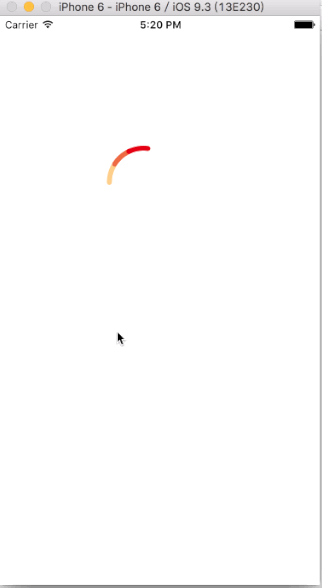详情参见GitHub,一个像蚱蜢一样跳跃的加载动画
原理:
首先,要完成这个动画,我们需要分析它有哪些需求:
- 需要有三种颜色的线段(当然是贝塞尔曲线)
- 动画的完成,使用核心动画无法完成
- 这个动画是周期性的
基于需求1,我们没有办法使用CAShapeLayer,因为CAShapeLayer画的图形,只有一种颜色,或者是渲染出来的过渡色,不能做到上面的三种颜色。所以我们使用Core Graphics自己绘制线段
那么我们怎么样让动画动起来呢?使用CADisplayLink。这种接近硬件刷新级别的计时器,可以让我们制作流畅的动画,我们内部维护一个最大值为1000的数字,随着定时器的滴答来“自加”。
在1000个计数周期中,整个动画完成单次循环。
下面我们对动画进行分解。
1)首先是弧形
路线是一个半圆,角度从-PI到0。一次动画循环,分为两部分。我们设这两部分是动画进度的percent0~0.5,和进度的percent0.5~1。
上半部分,弧形从-PI角度为起点,角度递增,到percent0.5的时候,正好是一个上半圆。
下半部分,弧形从完整上半圆开始(-PI起点,0终点),开始起点不断增加,到percent 1的时候,弧度夹脚为0,都落在了0角度。
2) 其次是平移
我们可以看到,整个动画似乎是在往前走,原因是,在percent 0的时候,弧度的起点在中心位置,等到percent 0.5的时候,弧度的圆心在中心位置,当percent 1的时候,弧度的终点在中心位置。不断的循环,给人向前跑的假象。
其实画图讲解更好,但是实在太麻烦了,大家可以自己动手画画,其实并不难~~
代码:
动画使用了Core Graphics和贝塞尔曲线来完成:
加载view的实现代码:
//
// GrasshopperLoadingView.m
// GrasshopperLoading
//
// Created by Realank on 16/4/18.
// Copyright © 2016年 realank. All rights reserved.
//
#import "GrasshopperLoadingView.h"
#import <math.h>
#define LINE_WIDTH 6
@interface GrasshopperLoadingView ()
@property (nonatomic, weak) CADisplayLink *link;
@property (nonatomic, assign) NSInteger count;
@end
@implementation GrasshopperLoadingView
- (id)initWithFrame:(CGRect)frame {
self = [super initWithFrame:frame];
if (self) {
// Initialization code.
}
self.backgroundColor=[UIColor clearColor];
_count = 0;
CADisplayLink *link = [CADisplayLink displayLinkWithTarget:self selector:@selector(clockTick)];
[link addToRunLoop:[NSRunLoop mainRunLoop] forMode:NSDefaultRunLoopMode];
_link = link;
return self;
}
- (void)dealloc {
[self deleteTimer];
NSLog(@"dealloc");
}
- (void)deleteTimer{
if (_link) {
[_link invalidate];
_link = nil;
}
}
- (void)clockTick{
if (self.superview) {
_count += 15;
if (_count > 1000) {
_count = 0;
}
[self setNeedsDisplay];
}else{
[self deleteTimer];
}
}
// Only override drawRect: if you perform custom drawing.
// An empty implementation adversely affects performance during animation.
- (void)drawRect:(CGRect)rect {
UIGraphicsGetCurrentContext();
CGFloat percent = _count / 1000.0;
CGFloat r = MAX(rect.size.width, rect.size.height) / 2 - 10;;
CGPoint center = CGPointMake(rect.size.width/2, rect.size.height - 5);
center.x = center.x - 2 * r * (percent - 0.5);
NSArray* pathArr = [self pathesForLoadingCenter:center andR:r andPercent:percent];
if (pathArr.count == 3) {
[[self colorWithR:251 G:205 B:137] setStroke];
[pathArr[0] stroke];
[[self colorWithR:237 G:105 B:65] setStroke];
[pathArr[1] stroke];
[[self colorWithR:230 G:0 B:18] setStroke];
[pathArr[2] stroke];
}
}
- (UIColor*)colorWithR:(CGFloat)r G:(CGFloat)g B:(CGFloat)b {
return [UIColor colorWithRed:r/255.0 green:g/255.0 blue:b/255.0 alpha:1];
}
- (NSArray*)pathesForLoadingCenter:(CGPoint)center andR:(CGFloat)r andPercent:(CGFloat)percent{
CGFloat startAngle = 0;
CGFloat endAngle = 0;
if (percent < 0.01) {
percent = 0.01;
}else if(fabs(percent- 0.5) < 0.01){
percent = 0.5;
}else if(percent > 0.99){
percent = 0.99;
}
if (percent <= 0.5) {
startAngle = -M_PI;
// CGFloat x = 2 * r * percent * 2;
// endAngle = startAngle + [self angleForDeltaX:(x - r) andR:r];
endAngle = startAngle + M_PI * percent * 2;
}else {
endAngle = 0;
// CGFloat x = 2 * r * (percent- 0.5) * 2;
// startAngle = -M_PI + [self angleForDeltaX:(x - r) andR:r];
startAngle = -M_PI + M_PI * (percent-0.5) * 2;
}
CGFloat segmentAngle = (endAngle - startAngle) / 3;
NSMutableArray* pathArr = [NSMutableArray array];
[pathArr addObject:[self arcPathAtCenter:center andR:r startAngle:startAngle endAngle:startAngle + segmentAngle withColor:[UIColor redColor]]];
[pathArr addObject:[self arcPathAtCenter:center andR:r startAngle:startAngle + segmentAngle endAngle:startAngle + 2 * segmentAngle withColor:[UIColor redColor]]];
[pathArr addObject:[self arcPathAtCenter:center andR:r startAngle:startAngle + 2 * segmentAngle endAngle:startAngle + 3 * segmentAngle withColor:[UIColor redColor]]];
return [pathArr copy];
}
- (CGFloat)angleForDeltaX:(CGFloat)deltaX andR:(CGFloat)r{
if (deltaX < -r || deltaX > r) {
NSLog(@"错误");
return 0;
}
if (deltaX < 0) {
deltaX = - deltaX;
return acos(deltaX / r);
}else if (deltaX == 0) {
return M_PI_2;
}else{
return M_PI - acos(deltaX / r);
}
return 0;
}
-(UIBezierPath*)arcPathAtCenter:(CGPoint)center andR:(CGFloat)r startAngle:(CGFloat)startAngle endAngle:(CGFloat)endAngle withColor:(UIColor*)color{
UIBezierPath *aPath = [UIBezierPath bezierPathWithArcCenter:center radius:r startAngle:startAngle endAngle:endAngle clockwise:YES];
aPath.lineWidth = LINE_WIDTH;
aPath.lineJoinStyle = kCGLineJoinRound;
aPath.lineCapStyle = kCGLineCapRound;
return aPath;
}
@end使用方法:
//
// ViewController.m
// GrasshopperLoading
//
// Created by Realank on 16/4/18.
// Copyright © 2016年 realank. All rights reserved.
//
#import "ViewController.h"
#import "GrasshopperLoadingView.h"
@interface ViewController ()
@end
@implementation ViewController
- (void)viewDidLoad {
[super viewDidLoad];
// Do any additional setup after loading the view, typically from a nib.
GrasshopperLoadingView *view = [[GrasshopperLoadingView alloc]initWithFrame:CGRectMake(100, 100, 100, 100)];
[self.view addSubview:view];
}
- (void)didReceiveMemoryWarning {
[super didReceiveMemoryWarning];
// Dispose of any resources that can be recreated.
}
@end
点击查看更多内容
31人点赞
评论
共同学习,写下你的评论
评论加载中...
作者其他优质文章
正在加载中
感谢您的支持,我会继续努力的~
扫码打赏,你说多少就多少
赞赏金额会直接到老师账户
支付方式
打开微信扫一扫,即可进行扫码打赏哦






